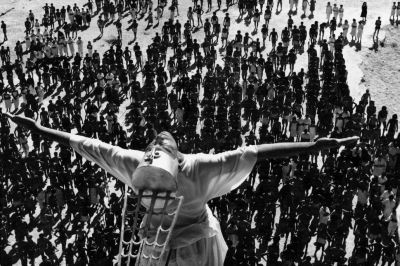
FARAON
(Il faraone/Pharaoh, Polonia/1965) R.: Jerzy Kawalerowicz. D.: 149'. V. polacca
T. it.: Il faraone. T. int.: Pharaoh. Sog.: dal romanzo omonimo di Bolesław Prus. Scen: Tadeusz Konwicki, Jerzy Kawalerowicz. F.: Jerzy Wójcik. M.: Wiesława Otocka. Scgf.: Jerzy Skrzepiński. Mus.: Adam Walaciński. Int.: Jerzy Zelnik (Ramses XIII/Lycon), Wiesława Mazurkiewicz (Nikotris), Barbara Brylska (Kama), Krystyna Mikołajewska (Sarah), Ewa Krzyżewska (Hebron), Piotr Pawłowski (Herhor), Leszek Herdegen (Pentuer), Stanisław Milski (Mephres), Kazimierz Opalinski (Béroès). Prod.: Zespół Filmowy Kadr. 35mm. D.: 149'. Bn. Versione polacca con sottotitoli inglesi / Polish version with English subtitles. Da: Filmoteka Narodowa per concessione di Studio Filmowe Kadr
Gli anni Sessanta furono l'epoca d'oro del film storico polacco. A partire da I cavalieri teutonici (1960) di Aleksandr Ford, i budget aumentarono, i film si allungarono e i migliori registi del paese ebbero l'occasione di lavorare su vasta scala con migliaia di comparse. Ciò non era di per sé un fatto positivo, ma contrariamente da quel che accadeva a Hollywood o nell'Unione Sovietica, dove un maggiore afflusso di denaro finiva spesso per soffocare il talento, i film polacchi di questo periodo dimostrarono che la grandeur produttiva poteva portare a creazioni più intense e personali. Il migliore esempio di questa qualità è Il faraone di Jerzy Kawalerowicz, tratto da un romanzo del 1897 di Bolesław Prus. Il film segue la lotta per il potere tra il giovane faraone Ramses XIII (Jerzy Zelnik) e i sommi sacerdoti, che hanno di fatto conquistato il potere approfittando della debolezza dei suoi predecessori. Le basi storiche su cui poggia il romanzo sono state ormai da tempo smentite (non è mai esistito un faraone chiamato Ramses XIII), ma la sua analisi dei meccanismi del potere dovette sembrare attuale alla metà degli anni Sessanta, e oggi lo è ancor di più. Il fatto che il romanzo di Prus fosse uno dei libri preferiti di Stalin sottolinea l'esattezza e la validità delle conclusioni dell'autore sulla crudeltà del potere. Per quanto riguarda le allusioni alla contemporaneità, il film si presta a molte interpretazioni. Il popolo ebraico perseguitato trova facile collocazione nel contesto del XX secolo. I sommi sacerdoti possono essere associati alla potente Chiesa cattolica. Nel secondo dopoguerra il Partito comunista aveva assistito a più di una lotta intestina. Nel film di Kawalerowicz non c'è distinzione tra regnanti buoni e cattivi: ci sono solo bastardi che si contrappongono ad altri bastardi, in un conflitto nel quale i perdenti sono soprattutto i deboli e gli oppressi. Girato in Uzbekistan e in Egitto con la consulenza storica del futuro regista Shadi Abdel Salam (La mummia, 1969), Il faraone dimostra che un maggiore investimento produttivo può portare a un risultato di qualità. L'atmosfera fosca e tesa che domina il film conferisce la giusta distanza all'ambientazione storica, rendendola emozionante e credibile agli occhi dello spettatore moderno. Jerzy Wójcik sa cogliere la strana luce riflessa dal deserto e dai templi, sigillando l'intreccio in uno spazio remoto in cui tutti i personaggi paiono disperatamente isolati.
Petteri Kalliomäki
The 60s were the golden age of Polish historical spectacle. Starting from Ford's Knights of the Black Cross (1960), the budgets got bigger and films got longer, and all the finest directors of the country were given opportunities to work on an epic scale with a cast of thousands. This may not necessarily mean anything positive, but unlike Hollywood or Russia in the 60s, where more money led usually to dumbing down creative efforts, the Polish spectacles of the first wave proved that previously unfulfilled equation, that higher production values could actually lead to more personal and powerful films. Nothing provides a better example of this than Jerzy Kawalerowicz's Pharaoh, based on a classical novel by Bolesław Prus first published in 1897. The story follows the power struggle between young pharaoh Ramesses XIII (Jerzy Zelnik) and the high priests, who have gained virtual power over Egypt during the rule of his weaker predecessors. The Egyptological basis of the novel were crushed a long time ago (there never was a pharaoh called Ramesses XIII), but its analysis of the mechanics of power must have felt topical in the mid-60s - and needless to say, feel even more so today. The fact that Prus' novel is known to have been one of Stalin's favorite books underlines the exactitude and timelessness of the author's conclusions about ruthless policy-making. The film allows multiple interpretations of what amount to political and contemporary allegories. The persecuted Jewish people are easy to put in their place in the context of the 20th century. Powerful high priests may be associated with Poland's traditionally strong Catholic Church. The Communist party had seen more than one fierce power struggle inside its own ranks since the war ended. In Kawalerowic's film there is no struggle between the better and worse ruler: it is simply one asshole's fight against another, a battle where the biggest losers are the ones who were weak and oppressed in the first place. Filmed in Uzbekistan and Egypt with the future director Shadi Abdel Salam (The Night of Counting the Years, 1969) as a historical advisor, Pharaoh shows how a big budget can be turned into inner power at every level. The eerie, high-tension atmosphere dominating the film makes the far-away historical milieu suitably distant, exciting and more believable for the modern viewer. Jerzy Wójcik's camera captures the strange sunlight reflected by the desert and the temples, creating a vacuum-like ancient space around the story, where all the characters seem to be deeply isolated from each other.
Petteri Kalliomäki

Tariffe:
Aria condizionata
Accesso disabili
Tel. 051 522285











